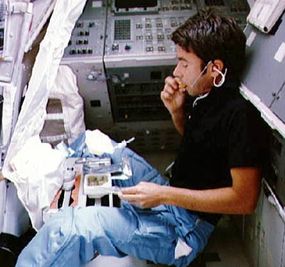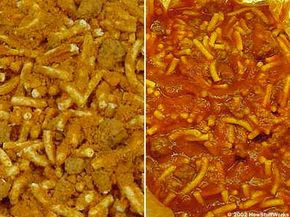Why Freeze-Dry?
The basic idea of freeze-drying is to completely remove water from some material, such as food, while leaving the basic structure and composition of the material intact. There are two reasons someone might want to do this with food:
- Removing water keeps food from spoiling for a long period of time. Food spoils when microorganisms, such as bacteria, feed on the matter and decompose it. Bacteria may release chemicals that cause disease, or they may just release chemicals that make food taste bad. Additionally, naturally occurring enzymes in food can react with oxygen to cause spoiling and ripening. Like people, microorganisms need water to survive, so if you remove water from food, it won't spoil. Enzymes also need water to react with food, so dehydrating food will also stop ripening.
- Freeze-drying significantly reduces the total weight of the food. Most food is largely made up of water (many fruits are more than 80 to 90 percent water, in fact). Removing this water makes the food a lot lighter, which means it's easier to transport. The military and camping supply companies freeze-dry foods to make them easier for one person to carry. NASA has also freeze-dried foods for the cramped quarters onboard spacecraft.
People also use freeze-drying to preserve other sorts of material, such as pharmaceuticals. Many pharmaceuticals will degrade pretty quickly when exposed to water and air, for the same basic reason that food degrades. Chemists can greatly extend pharmaceutical shelf life by freeze-drying the material and storing it in a container free of oxygen and water. Similarly, research scientists may use freeze-drying to preserve biological samples for long periods of time. Freeze-dried biological samples are also big in the florist world, oddly enough. Freeze-dried roses are growing in popularity as wedding decorations. The freeze-drying process has also been used to restore water-damaged materials, such as rare and valuable manuscripts.
Advertisement

It's pretty simple to dry food, drugs and just about any other biological material. Set it out in a hot, arid area, and the liquid water inside will evaporate: The heat gives the water molecules enough energy to "break free" of the liquid and become gas particles. Then you seal it in a container, and it stays dry. This is how manufacturers make dehydrated meals like powdered soup and baking mixes.
There are two big problems with this approach. First, it's difficult to remove water completely using evaporation because most of the water isn't directly exposed to air. Generally, dehydrating food in this way only removes 90 to 95 percent of the water, which will certainly slow down bacteria and enzyme activity, but won't stop it completely.
Secondly, the heat involved in the evaporation process significantly changes the shape, texture and composition of the material, in the same way that heat in an oven changes food. Heat energy facilitates chemical reactions in the food that change its overall form, taste, smell or appearance. This is the fundamental purpose of cooking. These changes can be good, if they make the food taste better (or taste good in a different way), but if you're drying something so you can revitalize it later, the process compromises quality somewhat.
The basic idea of freeze-drying is to "lock in" the composition and structure of the material by drying it without applying the heat necessary for the evaporation process. Instead, the freeze-drying process converts solid water -- ice -- directly into water vapor, skipping the liquid phase entirely. In the next section, we'll find out how freeze-drying machines pull this off.
